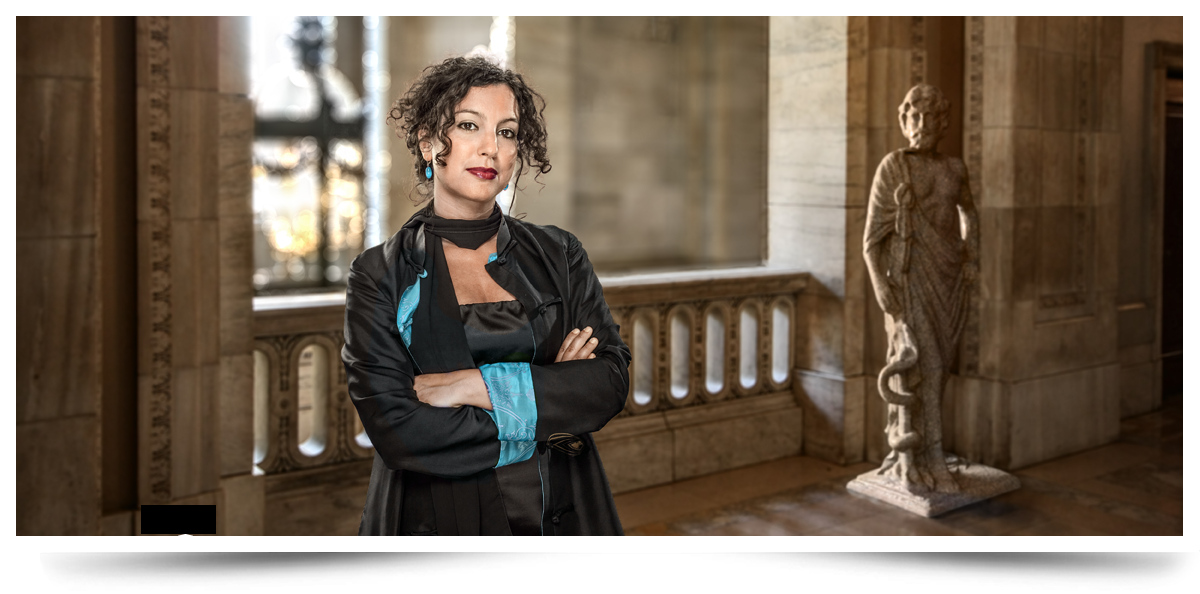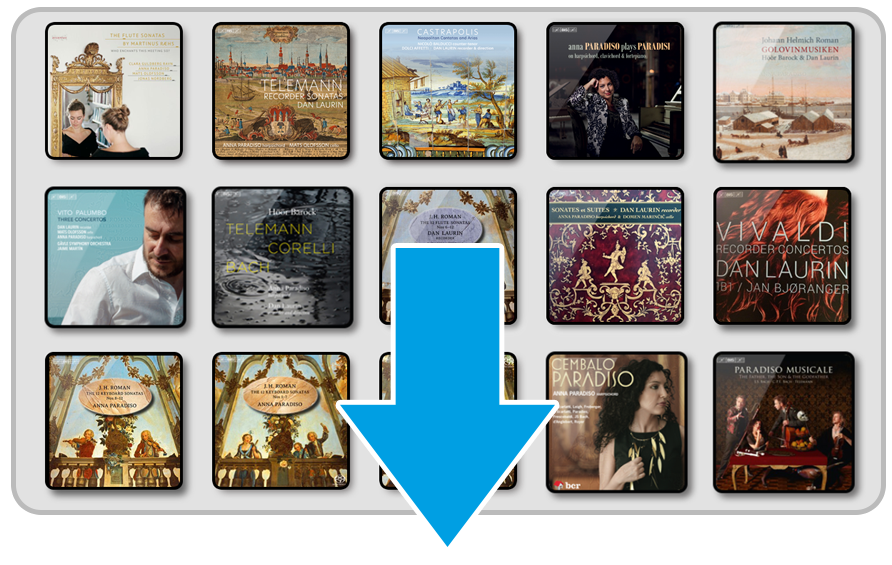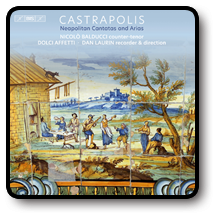
Castrapolis
Castrapolis, Neapolitan harpsichord concerto and arias with Nicolò Balducci countertenor, Dan Laurin direction BIS 2022
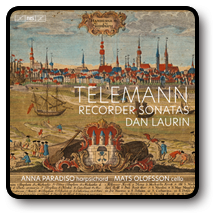
Telemann
Telemann, Recorder sonatas, Dan Laurin recorder, Anna Paradiso harpsichord, Mats Olofsson cello BIS 2022
Recommended by Klassik Heute (Germany): 10/10 to artistry, sound, overall impression.
“Eureka, we have a new reference recording of the Telemann sonatas.” “Gorgeous continuo playing. Anna Paradiso’s glaring double trill at the beginning of the middle section in A flat major in the Allegro of the F minor sonata is simply genial. Great teamwork!”
“If the grand seigneur of the recorder, Dan Laurin, has waited until after his 60th birthday (to record this), one can hope for the extraordinary and this hope will not be disappointed.”
“It doesn’t get any better! Absolute recommendation!”
“Someone who finds the ornaments too excessive should take a look at the “Methodical Sonatas” written by Telemann as a “school of ornamentation”. In addition, they are neither an end in themselves nor a show, but each supports the rhetorical statement.”
The whole review here: http://www.klassik-treff.de/4daction/www_medien_einzeln?id=24072&CDS30
Cultuurpakt (Belgium):
“… a living portrait painted with a recorder. Can an instrument be more significant?’.
https://www.cultuurpakt.be/cd-lp/georg-philipp-telemann-een-bewogen-blokfluitreis/
BBC Radio (UK):
“If there is one man that has made an unfadingly case for Telemann this is the recorder-player Dan Laurin (…) Dan Laurin, Anna Paradiso and Mats Olofsson revel in the wide technical and emotional scope of the sonatas … Dan Laurin makes these recorder sonatas sing, and soar, and plumb the depths too”
Gramophone (UK)
“… if that has you hoping for some strong opinions, then you’re in luck. Take the degree of rhetorical freedom with which Laurin launches into the curtain-raising Sonata in C, TWV4I:C5, encouraged by the lack of counterpoint to pack its opening Adagio with florid embellishments. Then as the counterpoint increases harpsichordist Anna Paradiso and cellist Mats Olofsson are alive to Laurin’s every metrical tug, answering his phrasing and articulation in kind. For a similarly engaging metrical unpredictability, listen to the energetically leaping Allegro of the Sonata in C, T\{V41:C2, at the album’s end. Yet these readings don’t lack steady rhythmic pulse where it counts. Laurin leans into the dissonances of the Largo of the Sonata in F, TWV41:F2, where Paradiso’s counterpoint is ear-grabbingly involved and the simple beauty of Olofsson’s bass line binds the whole together. These musicians also embrace drama, such as in the Sonata in D minor, TWV4I:d4.Listen to Laurin’s dynamic contrasts, pronounced sighs and range of tone production coloring the intense opening Affettuoso; the strong-armed muscle of their Presto, peppered with sudden surprise abatements in tempo and force; or the Grave’s stabbing continuo chords coming with such violent, thundering weight from Paradiso and Olofsson that I find myself thinking more of a Vivaldian orchestra than of the trio sonatas.”
Stretto (Belgium): https://www.stretto.be/2022/08/08/telemann-recorder-sonatas-door-dan-laurin-blokfluit-anna-paradiso-klavecimbel-en-mats-olofsson-cello-op-het-label-bis/
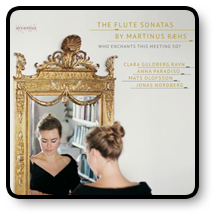
THE FLUTE SONATAS BY MARTINUS RÆHS (arcantus)
Clara Guldberg Ravn, recorders
Anna Paradiso, thorough bass on harpsichord & fortepiano; Jonas Nordberg, theorbo; Mats Olofsson, baroque cello
Recommended by Klassik Heute (Germany): 10/10 to artistry, sound, overall impression.
‘The formidable continuo group played a major role in the lively effect of this recording with Anna Paradiso, Jonas Nordberg and Mats Oloffson … With this colorful counterpart (to the soloist), which is exceptionally imaginative in the realizations of the figured bass, and which concurs to the ‘affetti’ (…) Work, performers, the instruments played and even the technology used are exemplary! Enjoy brilliant entertaining music. Vivid recommendation!’ Thomas Baack
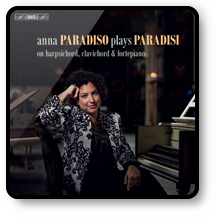
ANNA PARADISO, HARPSICHORD, ORIGINAL CLAVICHORD, ORIGINAL FORTEPIANO
‘Anna Paradiso plays Paradisi’ – BIS Records, May 2020
‘Recommended’ ‘With this recording she reinforces her reputation as one of today’s leading keyboard players’ (Dominy Clements, Musicweb-international)
‘Paradisi wrote twelve Sonate di gravicembalo, and in the ten selected here Anna Paradiso has “tried to underline Paradisi’s theatrical idiom, with all its different gestures, through phrasing, rubato and flexibility in tempo changes as well as different kinds of touch.” She adds tasteful and idiomatic ornamentations, and her expressive approach does indeed add some of the surprise and drama you might expect from C.P.E. Bach to go along with the acceptability and ease of the ‘galant’ style. The two-movement form of each of these sonatas hides a surprisingly wide variety of moods, and Paradiso takes advantage of the expressive qualities of a very fine sounding clavichord for Sonata IV in G minor, with its extended fantasia like Andante first movement. This is an original instrument from 1792, as is the 1802 John Broadwood & Sons fortepiano used in Sonata VI, which is a few years outside Paradisi’s lifetime but has most of the qualities of sound of the fortepianos that were becoming popular in his time. The dynamic contrasts offer a wealth of expressive light and shade just not possible on harpsichord, and some of the music-box pedal effects are truly delightful – sparingly used, but much appreciated. The harpsichord used is also very fine sounding indeed: a recent copy of a French instrument from 1730 that has a satisfying sparkle and subtle variety of tone over its range that brings out the dramatic qualities that Paradiso emphasises in her playing. The beautiful Aria second movement of Sonata III also reveals how expressive the harpsichord can be, contrasting through use of a lute stop to create “a little, magic pool of intimate and sweet longings…”. Anna Paradiso introduced Paradisi into the programme of her debut recital back in 2013 (review), and with this superbly engineered BIS recording she reinforces her reputation as one of today’s leading keyboard players. There are a few recordings of Paradisi’s sonatas around, including Filippo Emanuele Ravizza on the Concerto CD label (review). Recorded only on harpsichord and spread over two discs, this doesn’t have the variety of Anna Paradiso’s set (…) At a hair under 88 minutes this BIS album is going to be one of the longest in your collection, and there is even a little hint in the booklet to remedy problems you might encounter with it on your CD equipment. I had no trouble even with an ancient player I only keep around as it has a handy programme function for adding up track timings, so you certainly shouldn’t be put off by having too much of such excellent music.’
‘Recommended’ ‘Recovering and restoring all the sonatas is the performer’s welcome gift to all us’
(Philip Kennicott, Gramophone)
‘The keyboard sonatas of Pietro Domenico Paradisi are robust, inventive works, first published in London in 1754. Anna Paradiso misses not a whit of the interest the Neapolitan composer embedded in this music, and she adds considerable invention and drama of her own in these entirely satisfying interpretations. Performing on harpsichord, fortepiano and clavichord, Paradiso finds a world of variation in these compelling works, some of which broach a chromaticism that seems more of the 19th than the 18th century.
(…) The resemblance to Scarlatti doesn’t minimise the individuality and brilliance of Paradisi’s idiom, which often feels more of the theatre than the keyboard. The performer’s decision to use the full panoply of keyboard instruments available at the time these works were published (minus, of course, the organ), is brilliant. It pushes this music to its extremes, and it is music that wants that push. In the Andante of Sonata No 4, performed on clavichord (a restored 1792 instrument originally from Sweden), it sounds as if she is alone in a room, improvising on a lute, exploring the possibilities between pianissimo and silence, an impression not dispelled by the occasional dry thump of a left-hand octave or four-note chord. In the Larghetto of Sonata No 3, performed on the harpsichord (a contemporary instrument based on a 1730 model by Nicolas and François Blanchet), deft use of the buff stop gives textural variety and increases the drama, which at points in the middle of the movement almost approaches the chromatic intensity of the 25th variation of Bach’s Goldbergs.
Paradiso is a daring performer, including performing the only work here that is even modestly well known – the ‘toccata’ second movement from the Sonata in A major – on the fortepiano (a restored 1802 Broadwood). Paradisi lived a long life and died in 1791. These works were written decades earlier than the turn of the 19th century, and might seem alien to the fortepiano’s tonal world. Yet the dynamic nuance of the instrument and its range of texture perfectly suit this sonata, especially the first movement, which is one of the delights of the disc. Recovering and restoring all the other sonatas is the performer’s welcome gift to all us.’
Opusmagasin top-list 2020 / Opuslistan 2020. ‘Harpsichord hard-rock riff that you want to hear again and again’ (Opusmagasin)
‘(This recording) impressed, among others, Gramophone for the way the Italian-Swedish harpsichordist approached her namesake … ‘The Italian gallantries become harpsichord hard-rock riffs that you want to hear again and again’ wrote Opus’ reviewer Hanna Höglund. Our editorial staff can only agree.’
‘Highly recommended’
Stretto Magazine (Michel Dutrieue)
‘… Widely praised for her recordings of solo works and chamber music by the Swedish composer, Johan Helmich Roman (1694-1758), Anna Paradiso now lets us enjoy the playfulness and expressiveness of Paradisi’s keyboard music, composed in the line of Alessandro and Domenico Scarlatti. Highly recommended …’
‘Anna Paradiso is the perfect guide’ (Johan van Veen, Musicweb-international)
‘There is every reason to welcome these performances by Anna Paradiso, whose previous recordings (for instance of sonatas by the above-mentioned Roman) I greatly appreciated. Here again, I notice her creative approach to the material: she takes some liberties, but – as far as I can see – all within the boundaries of what is historically tenable, for instance with regard to ornamentation and agogics. The latter aspect is a particular pleasing and important one, as by treating the tempi with some freedom, she creates a nice amount of tension. These performances are strongly rhetorical, and remind us once again how important the classical rhetoric was in performance practice in the 18th century. With the use of the clavichord and the fortepiano, this disc is also a real alternative to the recordings that are already on the market.
If you don’t know Paradisi’s sonatas yet, this disc offers an excellent opportunity to get to know them. They were popular for a reason, and Anna Paradiso is the perfect guide.’
‘Varied keyboard recital is a match made in paradise … highly recommended.’ (P. Ballam-Cross, Limelight, Australia)
Paradisi’s music is in the super-theatrical galant style, and boy-oh-boy does Paradiso highlight it. Although the harpsichord is limited in its ability to change dynamics, Paradiso nimbly alters phrases, tempos, and rhythms to keep the listener guessing in the various harpsichord sonatas. There are yet more colours to hear, though, since she takes a surprising route and plays some of the sonatas on both clavichord and fortepiano. So simple, but it really does enliven the whole release up – hearing the ways that both the instruments and Paradiso’s performances shift across the album is fascinating. The appearance of the resonant fortepiano Sonata No 6, for instance, comes as a complete surprise after a few tracks of harpsichord pieces, and to follow that soon after with the short, spiky clavichord is inspired … this is a release of rare range and variety, with not a dull moment to be seen. Highly recommended.’
Sonates de Paradisi : Paradiso brûle les planches. L’intégrale qu’on attendait ! (Christophe Steyne, Crescendo Magazine)
Son : 10 – Livret : 10 – Répertoire : 9 – Interprétation : 10
’Cet album s’avère donc bienvenu ! Même si le cahier est expressément dédié au clavecin, le disque confie trois sonates au clavicorde (un modèle suédois de 1792) et deux au pianoforte (un Broadwood de 1802), ce qui n’est guère absurde dans la mesure où la popularité de ces pages au cours du siècle les a probablement fait entendre sur d’autres ressources que les plectres. L’interprète explique dans le livret comment elle a réfléchi à la distribution entre ces trois instruments. L’intimisme des sonates 2 et 4 correspond bien au caractère feutré du clavicorde, auquel toutefois la démonstrativité de la cinquième semble faire violence : un choix assumé par Anna Paradiso qui admet là s’être posé un défi « en explorant comment la musique virtuose peut parvenir à de nouveaux résultats expressifs ». C’est précisément l’expressivité (doux euphémisme) qui frappe l’écoute ! Les quelques étapes poétiques sont servies avec une fine sensibilité, faisant de toute grappe vendange. Et ailleurs l’interprète fait feu de tout bois, imposant un regard extraverti et volontiers dramatique, dans une esthétique quasiment Stum und drang. Aucune difficulté (zébrures, croisements de main, galops intrépides) n’indispose les doigts qui semblent s’en stimuler. Et nous émoustillent ! Armé d’une superbe captation, tout en couleur et en relief, voilà enfin le disque pour redécouvrir Paradisi et comprendre pourquoi ces sonates furent tant jouées à leur époque, et vantées par Charles Burney dans sa référentielle General History of Music (1789). Combien loin d’une grâce salonnarde pour amateurs du dimanche. Ce compositeur qui subit tant d’infortune pour faire reconnaître ses partitions de scène, semble conquérir une revanche posthume : par son ardent lyrisme et sa théâtralité, l’album d’Anna Paradiso brûle les planches.’
‘Anna Paradiso has done an admirable job of entering the composer’s world and inviting us inside’ (Roymond Tuttle, Fanfare, USA)
‘… Paradiso’s performances are as energetic as Filippo Emanuele Ravizza’s, but they also are more lyrical and ingratiating. She clearly is an imaginative musician who is not afraid to take risks. Those risks are taken not in service of her ego but in her attempt to come closer to how the music would have been played and heard in the second half of the 1700s. In the first movement of the Sonata No. 9. for example it is interesting to compare Paradiso, who is quite free with the music, with Ravizza, who tends to play it straight down the middle. Freedom can be taken too far, of course, but I think Paradiso knows her limits, and I did not hear anything on this disc that distorted the music or that seemed untrue to the composer. These are not safe performances, but no one in their right mind could call them predictable or stodgy … I think that Anna Paradiso has done an admirable job of entering the composer’s world and inviting us inside.’
‘Excellent musicianship and sometimes fastest fingers in the business‘
Robert von Bahr, head of BIS Records: ‘Well, even for us (…) this is unusually long, at 3 seconds short of 88 minutes. And I beg your pardon for the name, but we couldn’t help ourselves – Paradiso plays Paradisi (Anna resp Pietro). One could think that 88 minutes of harpsichord playing of only one composer, not named Bach or Scarlatti would be a bit too good, but it isn’t. The music is very varied, and Anna uses three different instruments for variety, harpsichord, clavichord and fortepiano. This comes out amazingly well, and with Fabian Franck from arcantus as producer/engineer, the sound is on par with the excellent musicianship and sometimes fastest fingers in the business.’
‘We get both good, beautiful, new music from 1750, but also an image of how sound developed‘
Review on Radio P1, ‘Kultur’ Swedish National Radio:’Anna Paradiso var med på den Grammisvinnande och mycket uppskattade CDn med Johan Helmich Romans Golovinmusiken som kom förra året. Hon använder sig av tre olika instrument och det gör att de 88-minuterna blir väldigt varierade. Hon spelar på cembalo, klavikord och dåtidens piano.
I den här musiken har vi en linje framåt, som vanligt, en melodi, teman och omtag. Men om vi har den linjen så har vi också drillar och utsmyckningar “på stället” så att säga. Upprepningar, variationer.
Det roliga med instrumentvalet är ju att vi får både bra musik, vacker, ny musik från 1750-talet, men också en ljudbildsutveckling. Samtidigt en liten resa från de fina salarna med cembalon, till folkets rum med klavikordet. Sedan de större rummet, när cembalons knäppningar byttes mot pianots lilla hammare som slår mot strängen.’
‘Sparkling performances‘
Classical CD Review: ‘Anna Paradiso specializes in early music for the harpsichord and here plays all of Paradisi’s sonatas. She wrote program notes and explains her approach to this music, adding ornamentation as she felt appropriate. The result is sparkling performances of music that doubtless will be new to most listeners. (…) The recordings were made November 2018 in Sweden’s Petryskykan, Danderyd, and engineers have captured the delicate sounds of the instruments in splendid multi-channel sound.’
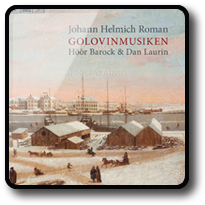
JOHAN HELMICH ROMAN:Golovinmusiken (BIS)
Höör Barock & Dan Laurin (direction), Anna Paradiso (harpsichord)
WINNER AT THE SWEDISH AWARDS (GRAMMIS): BEST CLASSICAL RECORDING OF THE YEAR
‘Making use of a total of 18 different instruments – from sopranino recorder and oboe da caccia to bassoon, strings and baroque guitar – and featuring highly imaginative continuo playing from Anna Paradiso at the harpsichord, their performance sounds as full and varied as one might wish for, without any added parts. Laurin’s performing version also follows the order of Roman’s score, creating a number of smaller suites out of this greater whole that a wider audience now can enjoy for the very first time.’
http://www.eclassical.com/performers/laurin-dan/jh-roman-the-golovin-music.html
Klassik Heute Recommendation: 10/10 Artistic quality, Sound quality, General impression.
’Fazit: Eine begeisternde Aufnahme von hochinteressanten Stücken, die man einzeln – ohne, dass es negativ auffiele – in Händels Wassermusik oder eine der Telemann-Ouvertüren, denen Roman stilistisch durchaus nahesteht, schmuggeln könnte. Für Barock- und HiFi-Fans ein Muss!’ The whole review is here: http://www.klassik-heute.de/4daction/www_medien_einzeln?id=22850
‘The experience is sensational’
‘Dan Laurin makes a glittering party dramaturgy by Roman … When (all this) is brought to life by Dan Laurin and Höör Barock the experience is sensational … With colourful varied instrumentation, fearlessly contrasting tempo-choices and a brilliant musicianship, the 45 short movements build up a glittering party dramaturgy – from the wildly engaging to the sweetly relaxing …’ (newspaper Dagens Nyheter; transl. from Swedish by AP)
“I have been so childishly delighted to be able to play this crispy, lively music in its whole (for seven weeks). It is not just me who enjoyed the music … It has been a pleasure for me to play Golovinmusiken by JH Roman. I hope that it has been a pleasure for you as well to listen: I cannot think otherwise!” (Per Feltsin, Swedish Radio, Söndagsmorgon i P2; transl. from Swedish by AP)
5/5 full marks in Musikrevyn Swedish Radio P2
“The bravura of these eleven musicians, who unfold a true firework of joy and virtuosity on 24 different instruments, makes this CD a listening pleasure”Bayerischer Rundfunk
“A treasure-chest of baroque sounds …“
“Johann Helmich Romans bästa tid är nu! (…) I vintras (…) släpptes också denna, lika anspråkslösa som generöst slösande, Golovinmusik av Romans ständige förkämpe, blockflöjtisten Dan Laurin. Mer levande än såhär är det nämligen svårt att föreställa sig Roman just nu, i den här ovanliga inspelningen av ett stycke som skrevs för ett ryskt barockparty hos ministern Golovin i Stockholm 1728. (…). De uppfinner Romanhjulet på nytt. I pragmatisk anda tar de instrumenten de har och fyller i där tonsättarens egna musikaliska anvisningar faller till föga. Och musikaliskt är det en skattkista av barockklanger där Laurin lämnar lika stort utrymme åt sina kollegor som åt sig själv: Joakim Peterson som solar på löjligt låg kontrabas. En plötslig elfiolföring på ett spår. Starter och inbromsningar i den musikaliska retoriken, udda glidningar på flöjten som man vill höra igen men när man tror att ett da capo ska komma har Laurin redan gått vidare och gör en lurig drill istället. Det är fint, det är fult, framför allt är det ett 1700-talslik som lever, för att anspela på Ernst Brunners boktitel. Och man vill bara höra mer, se detta live, uppleva leken på nära håll.” OPUS
“Playful ensemble – Laurin’s Ensemble Höör Barock is, as a soloist, of multicolored delicacy, combines a lively temperament with exquisite ensemble attitude. The solo basic gesture, carried by excellent individuals, combines to a fresh chamber music impulse, is determined by transparency and balance. The very different occupations bring the event to life clearly … Intonation is immaculate, no matter in which constellation. In extended chord, noble sonority can be heard; highest precision is maintained even in resolute dynamic attack. Articulatios is accurate to the smallest detail, for example in the excellent double bass, which makes the event pleasantly airy thanks to the tight play … The sound of the hybrid SACD is plump and full, regardless of the constellation. It is always rich in details, it feels pleasantly warm and perfectly balanced … No doubt: Count Golowin and the young Tsar were well served with this music from the pen of Johan Helmich Roman. Dan Laurin and Höör Barock make this clear with this first complete recording of Golovin music. This is a witty pleasure, lively and multi-colored played – all-round spirited entertainment. (transl. from German) klassik.com
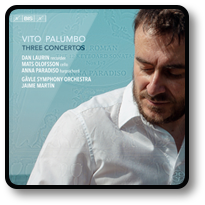
VITO PALUMBO (BIS)
Three Concertos (Anna Paradiso, soloist in C. B.)
’On the West side of the Alps, Italian composer Vito Palumbo (born in 1972) isn’t very well known yet, even though his music is played in abundance in many countries in the classical world. Right from the start, let’s say the first three seconds, one could very well imagine his 2006 Concerto barocco to be two hundred fifty years older, but after just two bars, the musical discourse diverts, becoming atonal, breaking up, while always keeping the rigorous form of baroque entertainment in mind. Granted the choice of the harpsichord as a soloist corrupts our vigilance and, much like in Martinů, Poulenc or Falla, one tends to think this is the work of a very old artist who would have gone mad! Regardless Concerto baroccois deliciously fresh and leads the listener to wonder how the next track on the album would sound like, in the present case his 2007 Cello concerto. And there, baroque references are nowhere to be found, we are thrown right in the 21st century – meaning the 70s and 80s avant-garde has been carefully left out in a language where musical beauty and phrases prevail, even if they are on the fringes of tone. The listener, growing further intrigued, starts wondering about what the 2013 Recorder concerto that closes the album might sound like… and how in the world a recorder can compete with a great modern symphonic orchestra! The recorder is indeed modern, from the brand Eagle, and its material, range, sound uniformity from bass to treble, and most importantly its power, make it equal to any of today’s transverse flutes. But with the sound of an unknown recorder. The music itself makes use of all the possibilities, plays with balance and unfolds with great modern beauty. Vito Palumbo, a name worth remembering! SM/Qobuz
’This turns out to be a very pleasant surprise’ musicweb-international.com
’Vito Palumbo lånar i Concerto barocco (2006) musikaliska motiv hämtade ur Vivaldis, J. S. Bachs och D. Scarlattis vokabulär, men han gör det med glimten i ögat. Harmonik och rytm tar plötsligt helt andra vägar än de tre föregångarna skulle ha kunnat ana. Verket andas en ungdomlig lätthet som är mycket tilltalande … Höjdpunkt Den charmiga och humorfyllda finalen i cembalokonserten.’ Opus
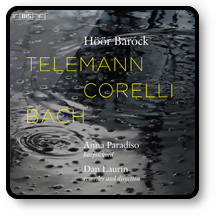
TELEMANN, CORELLI & BACH – BIS records
Dan Laurin, musical direction and recorders
Anna Paradiso, solo and continuo
Höör Barock
Release: December 2016
Buy it on http://bis.se/orchestras-ensembles/hoor-barock/telemann-corelli-bach
“This is, I think, a first release from Höör Barock, the orchestra founded in 2012 to perform at the festival in the village that bears its name in the southernmost part of Sweden. As such it is essentially a showcase, both of their own talents and of their fruitful relationship with recorder virtuoso Dan Laurin, and very effective it is, considering their particular strengths. ‘Individual voices are given ample space’, claims their group biography, and for once you can hear precisely what they mean. How much better for their natural expressive exuberance and freedom to be let loose in a mixed, presumably concert-derived programme rather than some sober one-composer set!
… there is an infectiousness to the interpretative energy of the music-making. The rhetorical daring and overspilling ornamentation are irresistible too, and must have made those Swedish summer evenings rock. With soloist Anna Paradiso they make the finale of Bach’s F major Harpsichord Concerto, arranged from the Fourth Brandenburg and already one of its composer’s most coursingly exciting, more scintillating than ever.
… the best thing to do with these fresh-faced Swedes is surely simply to enjoy their playing and say thank you for the music!”
(Gramophone UK)
The young period band Höör Barock, based in the south of Sweden, has chosen a colourful programme for its début disc. With recorder virtuoso Dan Laurin at the helm, the twelve musicians steer a course through Telemann’s celebrated Wassermusik (also known as Hamburger Ebb’ und Fluth) with its sea gods and goddesses dancing bourrées and gavottes before a rowdy crowd of seamen closes the suite with an energetic Canarie. The centre piece of the programme is Bach’s Harpsichord Concerto in F major, the composer’s arrangement of his own Brandenburg Concerto No. 4. Soloist here is Anna Paradiso, who also plays continuo in the other works of the disc. Bach is flanked on either side by two of the Op. 6 concerti grossi by another Baroque heavyweight, Arcangelo Corelli. His Concerto No. 4 and No. 8 – the much-loved Christmas Concerto – appear here in a slightly unusual guise. They are usually performed by strings alone, but inspired by recent research, Dan Laurin and his recorder-playing colleague Emelie Roos here take on the solo parts, and the tutti ensemble is joined by oboes and bassoon – while a baroque harp adds to the angelic atmosphere of the closing Christmas Pastorale of Concerto No. 8. The disc closes as it began, with Telemann, whose Concerto in B flat major for winds, strings and basso continuo is a perfect example of the composer’s art, involving playful juggling of different instrumental combinations and musical ideas.
“The new Swedish historical-instrument group Höör Barock (the name comes from that of a village in southern Sweden but also connotes the idea “hear Baroque”) is a project of recorder virtuoso Dan Laurin, already noted as one of the world’s top players on his instrument. Here, joined by second recorder Emilie Roos, he is able to shape his ensemble of ten players into a unit capable of keeping up with and pushing his blistering speeds … the fun starts with the CorelliConcerto for two recorders and orchestra, Op. 6, No. 4: sample the zippy duo passagework in its third and fourth movements. The Bach Concerto for harpsichord, two recorders, strings, and continuo, BWV 1057, is an arrangement of the Brandenburg Concerto No. 4 in F major, BWV 1049, and Höör Barock‘s performance here is likewise a masterpiece of close high-speed ensemble work … in the main this recording announces a distinctive new Baroque group, nicely recorded.” allmusic.com
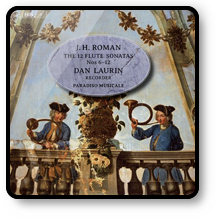
JH ROMAN – BIS
Dan Laurin, recorder and musical direction
Anna Paradiso, harpsichord
“Raymond Tuttle reviewed the first volume of this complete traversal of the 12 Flute Sonatas by Swedish composer Johan Helmich Roman in Fanfare 39:1 (September/October 2015). He cited the music’s “intrinsic interest” and “attractiveness,” and the excellent playing of Dan Laurin and the continuo ensemble. Now here are the last seven of the sonatas, equally interesting and attractive, fitted onto one SACD of over 80 minutes. Laurin is uncommonly expressive in this music—actually, he is all the time—treating these sonatas as dance music in a suite, which is usually what they are. The result is revelatory, as it was in the last volume.
The revelation comes to me because my prior experience with these sonatas for transverse flute, violone, and harpsichord was with the 2008 Naxos release with Verena Fischer on baroque flute. I liked it when I heard it, but I have to say that when I went back to it after hearing Dan Laurin and company, it seemed rather stodgy in comparison. Laurin makes the solo line come alive in a way that Fischer’s perfectly respectable performances simply don’t. It isn’t the use of baroque guitar or theorbo that makes the difference, though the addition of that color in certain movements, notably the Piva of the tenth sonata, is characteristic of the imagination with which these performances are approached. It comes down to finding the magic in the notes instead of simply playing them well.
I also listened to Jed Wentz’s recordings (Brilliant), using traverse flute as well, based on Bertil van Boer’s recommendation in 39:6. He and his ensemble of period instrument artists are very good interpreters as well. Van Boer goes into some detail on the provenance of these pieces, so I’ll refer the reader to his review for that. I’ll just take one exception to his assessment of Wentz’s playing; he says, “His tone is clear and the intonation precise.” The former is true, the latter occasionally is not. In fact, his tendency to drift flat on held-note phrase-offs made it hard for me to appreciate the many good things about his playing. It’s a major issue for me, perhaps because players like Fischer, and Laurin on recorder, correct this flattening on diminuendos.
The comparison with Wentz also revealed some interesting differences in the readings of the works, as where Laurin takes the Larghetto movement in the seventh sonata in 12 while Wentz takes the same in four. The published score is in 12/8, but while it is odd to have three consecutive slow movements, Laurin and company make the more leisurely journey just as interesting: maybe more so. He actually takes about a third of his personal note discussing this decision. Another contrast, again in tempo, occurs in the ninth sonata where Laurin takes the vivace second movement at a lively moderato so that the many grace figurations are clearly articulated. It is indeed vivacious. Wentz takes the same movement at an allegro, but he must add a slight hesitation for many of the figures, so that the effect is somewhat clumsy. Further, the concluding minuet is rather fast for that courtly dance, as are several other concluding dances where Wentz seems more concerned with a swift conclusion than a characteristic tempo. Laurin is unerringly stylish in all this.
He is, as well in the harmonic treatment of the figured bass, though perhaps here credit should be given to Paradiso Musicale: Anna Paradiso, harpsichord; Mats Olofsson, cello; and Jonas Nordberg, baroque guitar and theorbo. Citing an influential Italian harmony thesis that Roman translated into Swedish, Laurin argues persuasively for an Italianate approach to the harmonization, which adds to the splendid effect of these performances. There are extensive additional notes on Roman and his sonatas, and the BIS imprint assures the highest quality in sound. Highly recommended. Ronald E. Grames” Fanfare (USA)
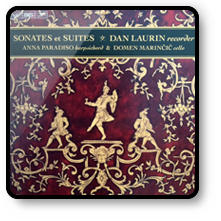
Sonates & Suites – BIS
Dan Laurin, recorder and musical direction
Anna Paradiso, harpsichord
“Anna Paradiso’s accompaniments are unfailingly sympathetic and stylish … (Dan Laurin’s) masterful solo recorder arrangement of Marais’sCouplets de folies (originally for bass viol) represents a departure from the usual arrangements with continuo and not only shows the recorder to fullest effect but also illustrates his own considerable musicianship …” Grammophone UK
‘Husband (recorder) and wife (harpsichord) fit together so perfectly that you hope they’ll have many more chances to make music together!’ American Record Guide
‘… Anna Paradiso’s splendid harpsichord playing (is) is so essential to creating the mood of all the other music … (Dan) Laurin’s playing is brilliant as always, and it is fascinating to hear how he incorporates into it the essential elements of the French style. So many performers are inhibited by Hotteterre’s instructions on how to ornament his music. Not so Laurin, who uses all the flattements, inégalité, wide trills and other graces to produce a sparkling performance. His own extraordinary arrangement for solo recorder of the Marais Folies d’Espagne for bass viol and continuo is surprisingly effective … Slovenian cellist Domen Marinčič is an equal partner in all the pieces with a particularly interesting bass line. I shall certainly be returning to this disc’ Early Music Review
“… The increasingly theatrical style of French chamber music – under the influence of the Italian style – is reflected by the way Dan Laurin plays this interesting programme. His playing is full of contrasts, in mood, tempo and dynamics. The recorder has a limited dynamic range but Laurin explores it to the full. These are strongly gestural and dramatic interpretations in which Laurin receives excellent support from Domen Marinčič and Anna Paradiso. This is not just another disc with recorder music. Because of the programme and the performances it is a substantial addition to the discography. The more than generous playing time is another good argument in its favour” music-web international
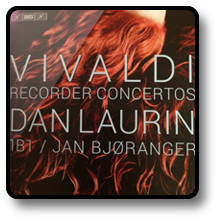
Vivaldi, Recorder Concertos – BIS
Dan Laurin, recorder and musical direction
1B1 / Jan Bjøranger, leader
Anna Paradiso, harpsichord
Jonas Nordberg, theorbo, baroque guitar
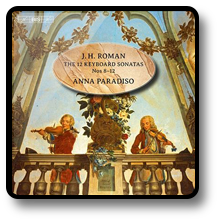
Johan Helmich Roman: the keyboard sonatas 8-12, vol. 2
BIS, Jan. 2015
Anna Paradiso, harpsichord and clavichord vol. 2
“This is keyboard musicianship so superlative that I stopped the player after 20 minutes and immediately placed an order for the other volume. It’s that attractive and expressive. Anna Paradiso obviously listens very closely to her instruments as she plays them, and this makes her interpretations vivid. She makes the music sound freshly improvised by a creative genius. … The music is so inventive and inspiring I had to print out all 12 sonatas and start learning them. …The music is full of melodic and rhythmic surprises and harmonic tensions. For example, the D-minor Sonata (9) has a passage exploring G-flat and E-flat minor, a six-flat key also used in a movement in Sonata I. … After the 12th Sonata, Paradiso gives us another 14 minutes of music: a Sonata in C by Johan Agrell (1701 – 65). She remarks about both these composers: “It is a repertoire that requires a performance style that can capture the sudden changes of mood and mask as they occur”. That is exactly how she plays. … BIS’s sound is perfect, too. If you care about harpsichord and clavichord and music that you are unlikeLy to know, go buy this now. B LEHMAN” (American Record Guide, USA)
“Anna Paradiso knows how to do it. A masterly use of the clavichord’
Equality. Anna Paradiso knows how to use black and white in an excellent way.
It is certainly not so often that the chlavicord is under the spotlight, almost time for species protection! Especially if one listens to such a skillful player such as Anna Paradiso (what a perfect name for a pop-artist, by the way) approaching Swedish composer Johann Helmich Roman’s 12 sonatas for keyboard instrument. Which means, they can be played on any instrument, but the chlavicord seems to be just the right one (some are also performed on the harpsichord). Beside the beautiful interpretations, I am delighted by the superb sound. They have never been heard so clear before. This results into a a much closer relation to the music.” (Uppsala nya tidningar, Sweden; transl. by AP)
“… Anna Paradiso bedömer med sina internationella utblickar Roman som en tonsättare av internationella mått, och att det är så visar hon här. De stycken Roman skrev efter sin andra utlandsresa, som 1736 gick till bl.a. Neapel, är tydligt inspirerade av den neapolitanska stilen, påpekar hon, och det är en tradition Anna Paradiso är bekant med. Därför lyckas hon locka fram nytt liv ur musiken både när hon spelar cembalo och klavikord, detta ”sängkammarinstrument”, som man nästan får lägga örat till för att höra, men som var vanligt på 1700-talet. Livfullast är ändå hennes cembalospel. Anna Paradiso fyller ut skivan på ”fransk” cembalo med musik av vår andre store barockmästare, den sju år yngre Johan Agrell,kanske en gång elev till Roman, och att Anna Paradiso är en förnämlig musiker, som med temperament och inlevelse får musiken att leva och blomma utan att bli det minsta manierad, visar hon på den här skivan. Det här är riktigt bra!” (Kammarmusik Nytt, ‘Swedish Chamber Music Association Journal’, Sweden)
‘… Master Italian harpsichordist Anna Paradiso had not heard of Roman until she moved to Sweden, and now is recording many of his works for BIS. Her second SACD includes six of his sonatas along with a five-moment sonata by the German/Swedish composer Johann Agrell (1701-1765). If you have an interest in rarely-performed early harpsichord music, this is for you. Excellent audio, with the soloist in front.’ (Classical CD Review, USA)
‘Elegant, beguiling at times, exciting at others … I like her rubato, her inputs … and the choice of 3 instruments. The clavichord is a lovely thing to have, enjoy its expressiveness … This is a pretty good introduction to these sonatas. Oh dear, (at first) I did not want to see through all of this (SIC!) but her lively playing and the way she gets right inside and under the skin of every piece and the combination of different instruments is really attractive. She is such a story-teller and a performer. It is a complete package. If you want to learn something new and be captivated by a new sound, well, then give it a go!’ (BBC Radio 3, Record Review, United Kingdom)
‘This is the second volume of Anna Paradiso’s recording of the complete surviving keyboard works of Johann Helmich Roman … (and one sonata by ) Johan Agrell, who spent his working life in Germany. Paradiso plays on the same three instruments as in Volume 1, again matching the instruments effectively to the style of the particular sonatas: a Guarracino copy by Masao Kimua, a Blanchet copy by Francois Paul Ciocca and a copy by Dan Johansson of a clavichord by the Stockholm- based Philip Jacob Specken. The Swedish-style clavichord is particularly successful in two of the sonatas here. The liner notes are again extensive and highly informative and the recording quality is excellent. It is satisfying music played very idiomatically and makes another very enjoyable recording’ (Early Music Review, UK)
“… Anna Paradiso delivers splendid and imaginative performances. She is not afraid to add a personal touch to these pieces. She is quite generous in the addition of ornamentation and now and then she also adds chords and some improvisational elements. As I was able to follow the scores I noted that she uses these liberties in a sensitive way; it never occurs at the cost of what Roman wrote down. What Ms. Paradiso does here seems to me in line with what was common practice at the time and what was expected from interpreters. These elements certainly contribute to the attraction of these works and their impact on the listener. These are discs to which one can and should return regularly, both because of the quality and individularity of Roman’s sonatas and because of the way Anna Paradiso plays them.” (musicweb-international)
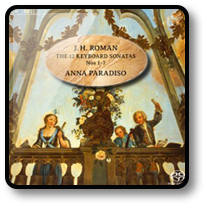
Anna Paradiso, harpsichord and clavichord vol. 1 -BIS
Johan Helmich Roman: the keyboard sonatas, vol. I
BIS, Jan. 2015
“Even though Johan Helmich Roman (1694-1758) is acknowledged as the father of Swedish music, his work is scarcely known and even less appreciated. He is generally thought of as an efficient composer who wrote nice but uninspired scores; as Anna Paradiso states in the liner notes, what she heard even from Swedes about his sonatas was that “some of them were nice but many others were boring.” After looking at his scores for these works and others, including one (the Sonata BeRI 224) in his own hand, and listening to the performances by pianist Oskar Ekberg (the first movement of Sonata BeRI 225, which opens Paradiso’s disc, may be heard on YouTube), I came to a similar conclusion. The music was nice but not exceptional.
Putting on this CD, however, one hears something entirely different. Paradiso applies the same kind of irregular rhythms, stop-start phrasing, rubato and rallentando effects to Roman that one normally hears in Buxtehude. At times, she even plays the two hands slightly out of synch, which makes the left-hand accompaniment change from a steady counterpoint to something wild and wonderful, notes that fall between the beats. She also uses tremendous dynamic contrasts, the sort of thing one hears in the music of C.P.E. Bach. For her, Roman’s sonatas are far from dull; they are “wonderful little” jewels. She takes her cue for the style of these works from the ornaments that “Roman himself suggested for Corelli’s violin sonatas – ornaments often extremely rich and weird to the ears of a modern musician.” With these in mind, she says, “I could have perhaps gone even further!”
There is, indeed, no question that in her hands the music of Roman comes to life. Each movement is exciting and unpredictable. I tend to agree with her regarding the performance style of these works since, as we know, composers of that time did not always write down everything they intended. The matter of phrasing, articulation, and ornaments was left up to the individual interpreter, and the style of the time is on Paradiso’s side.
It is difficult to pick out particular favorites, but for me the Sonata No. 5 in g minor, BeRI 229, was one such highlight. She pounces on the music like a cat taunting its prey, and the cat-and-mouse games she plays with articulation, phrasing, and rhythm are a feast for the ears.
So, should the success of this disc be attributed to Roman or to Paradiso? I would have to say both, but with 60% of its success attributable to her. Without her energy and imagination, these Roman sonatas would sound no different than the way Ekberg plays them, or the way they “look” on paper. This is, quite simply, an astonishing CD that one must hear to believe. The sound quality, unlike some of Bis’s recent harpsichord releases, is forward, clear, and crisp. The album’s title, The 12 Keyboard Sonatas: Nos. 1-7 suggest that a sequel is in the works. I certainly hope so.” (Fanfare, USA)
“Anna Paradiso … explains in the folder the principles and criteria that have guided her interpretation and we cannot avoid to recognize that she has wonderfully captured them. It is worth mentioning the care with which she carries out an authentic baroque phrasing, making of every musical gesture a world in itself, with its own timing and articulation. She uses a fantastic rubato (let’s see if others learn it!), which is essential for an adequate development of the musical speech, distinguishing each phrase, ornamenting at will and adding chords now and then … Truly a great disc, for the original repertoire and for the magistral interpretation. It is impossible to imagine a more effective reenactment of this music” (El arte de la fuga, Spain). Transl. A. Paradiso
” … (Roman’s) music is being revived almost single-handedly by harpsichordist Anna Paradiso, if this exceptional SACD from BIS is any evidence of her efforts on his behalf… the content is unpredictable and the style is dramatically arresting, influenced as it was by Neapolitan music, and Roman’s sudden changes in melodic shapes and harmonies are wholly Baroque in their quirkiness. Paradiso uses a fair amount of rubato to bring out these unusual features, and she invests a great deal of personality into these pieces, particularly in her free use of embellishment and improvisation … With the success of this recording, one hopes the remaining sonatas will be released in short order by Paradiso and BIS.”(Allmusic.com)
‘Anna Paradiso is fortunately adept at managing both the apparently irregular rhytmhs of these movements, and the proper ornamentation of everything heard on this album …. everything is dispatched with an ease and stylistic awareness that points to the experienced professional. Overall, I find her equally imaginative yet more period-aware than Joseph Payne’s highly personal account on BIS … Roman gathered 12 of these works, … As this disc contains seven, let’s hope we won’t have to wait long. Recommended.’ Barry Brenesal (Fanfare, USA)
“… a splendid recording” (Fanfare, USA – a review otherwise referring to Dan Laurin’s CD vol. I of Roman’s flute sonatas)
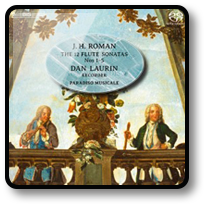 PARADISO MUSICALE/DAN LAURIN PARADISO MUSICALE/DAN LAURIN
Johan Helmich Roman: The 12 Flute Sonatas vol. I
BIS, March 2015
Recommended by Klassik Heute! Artistic quality 10/10, Sound Quality 10/10, Overall impression 10/10
“In den beiden bereits erschienenen Aufnahmen dieser Sonaten mit Traversflöte gehen Verena Fischer … mit liebenswerter Frische zu Werke; Maria Bania … und Lars-Ulrik Mortensen zeigen sich hingegen differenzierter … Im Vergleich der drei Einspielungen gebührt am Ende doch Dan Laurin die Krone: Mit herrlich weicher Tongebung und einer staunenswerten Fertigkeit auf seinem Instrument, die allerdings nie in circensische Selbstdarstellung ausartet, balanciert er ebenso virtuos wie der Komponist … Dabei wird Laurin bestens unterstützt von seinen Mitstreitern des Ensembles Paradiso, die mit ebenso lebendigem wie abwechslungsreichem Continuospiel begeistern …
Die besondere Atmosphäre dieser Aufnahme, und was die beiden Mitbewerberinnen und ihre Ensembles letztendlich ins Hintertreffen geraten lässt, zeigt sich exemplarisch am vierten Satz der vierten Sonate … Man sollte die Fortsetzung dieser Gesamteinspielung von Johan Helmich Romans Flötensonaten nicht versäumen!” (klassik heute)
“… Su protagonista aquí es formidable flautista Dan Laurin … Como no podía ser de otra forma, la interpretación de Laurin es espléndida, llena de matices y de delicadezas.” (Arte de la fuga)
“… The SACD sound is so good that you can hear Dan Laurin’s breathing and a faint jingle from the harpsichord … The disc forms part of a series of recordings of Roman’s music by the same musicians and I look forward to hearing their performances of the remaining seven sonatas in the set.” (Early Music Review). 5 stars in all cat.: performance, recorded sound, booklet notes, overall presentation.
“Here one is invited to great musicianship, filled with both deep knowledge and passionate spontaneity. It is like one hears these known sonatas for the first time, upgraded and transfigured” (HiFi & Musik, Sweden), 5 stars +
“One of the most significant composers in Swedish music of the Baroque era was Johan Helmich Roman, and his neglected works are undergoing a modest revival, thanks to the efforts of harpsichordist Anna Paradiso and her ensemble, Paradiso Musicale. Paradiso released a hybrid SACD of Roman‘s solo keyboard sonatas in 2014 on BIS, and for this 2015 audiophile disc, she has joined recorder player Dan Laurin, cellist Mats Olofsson, and guitarist Jonas Nordberg in performances of the flute sonatas Nos. 1-5. Stylistically, Roman was strongly influenced by Handel and Neapolitan music, and the arresting quality of his dramatic gestures and highly embellished and convoluted melodies is characteristic of his work. In these sonatas, any kind of pastoral mood is belied by flashy runs and elaborate ornaments that require virtuosic abilities, which Laurin and the basso continuo have in abundance. Because this is less than half of Roman‘s published set of 12 flute sonatas, one expects that Laurin and Paradiso Musicale will release another volume to complete them, to give a fuller demonstration of this composer’s worth.” allmusic.com
More reviews here!
https://www.facebook.com/anna.paradisolaurin
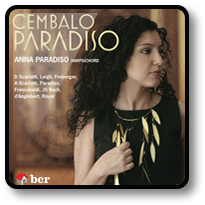 CEMBALO PARADISO CEMBALO PARADISO
Anna Paradiso, harpsichord
Barn Cottage Records (2012)
Music by: Frescobaldi, Froberger, A. and D. Scarlatti, Royer, Bach, Leigh, d’Anglebert.
“Exciting, characterful debut … The kind of lively, emotional and metrically irregular style employed by Paradiso is far more authentic than the straightforward, “rattle-trap” style of the majority” (Fanfare, USA)
“Volatile and powerful … Definitely worth experiencing” (Musica Antiqua, UK)
“There is much to admire here with highly characterized performances” (Early Music Today, UK)
“A very fine debut by a harpsichordist of whom I hope to hear more. This interesting and well-played program should be attractive to all lovers of the harpsichord” (MusiWeb International)
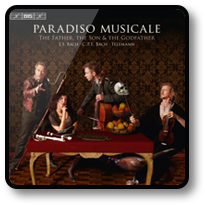 THE FATHER, THE SON AND THE GODFATHER THE FATHER, THE SON AND THE GODFATHER
Paradiso Musicale (Dan Laurin, recorders; Henrik Frendin viola; Mats Olofsson, cello; Anna Paradiso, harpsichord)
BIS 2012Music by Georg Philipp Telemann, C.P.E. Bach, J.S. Bach
“Paradiso Musicale is an ensemble of compelling soloists, each with virtuosity and insight to burn … With vivid recording, this is a hugely impressive debut disc” (BBC Music Magazine)
“Paradiso Musicale is a splendid quartet of players who together make music of the highest caliber and most splendid beauty“, (Fanfare USA)
“Nomen est omen: Diese CD ist paradiesisch!” (klassik-heute.de)
“Les quatre musiciens du ‘Paradiso Musicale’ nous font découvrir avecmaîtrise ce répertoire qu’ils défendent avec ardeur et passion.” (Pizzicato)
“Ein Privatissimum in Klängen über einen wichtigen Abschnitt der Musikgeschichte!” Ensemble
“A near-ideal Baroque chamber music recital that gives the music the weight and distinctiveness it deserves ” (Allmusic.com)
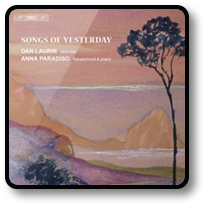 SONGS OF YESTERDAY SONGS OF YESTERDAY
Dan Laurin, recorder; Anna Paradiso, harpsichord / piano BIS 2011
Works composed for Carl Dolmetsch’s Wigmore Hall Concerts 1939-65 York Bowen, Edmund Rubbra, Cyril Scott, Herbert Murrill, Walter Leigh, Lennox Berkeley.
“Now that these composers are given the chance to speak for themselves, I doubt they’ll be soon forgotten.” American Record Guide; “Dan Laurin distingue bien chaque morceau avec son caractère propre et, bien soutenu par Anna Paradiso, il fait briller sa flûte à bec de mille couleurs.” Pizzicato; “Highly attractive and the playing is superb.” MusicWeb International; “Eine willkommene Aufnahme von hohem Repertoirewert!” Klassik-Heute.de |
